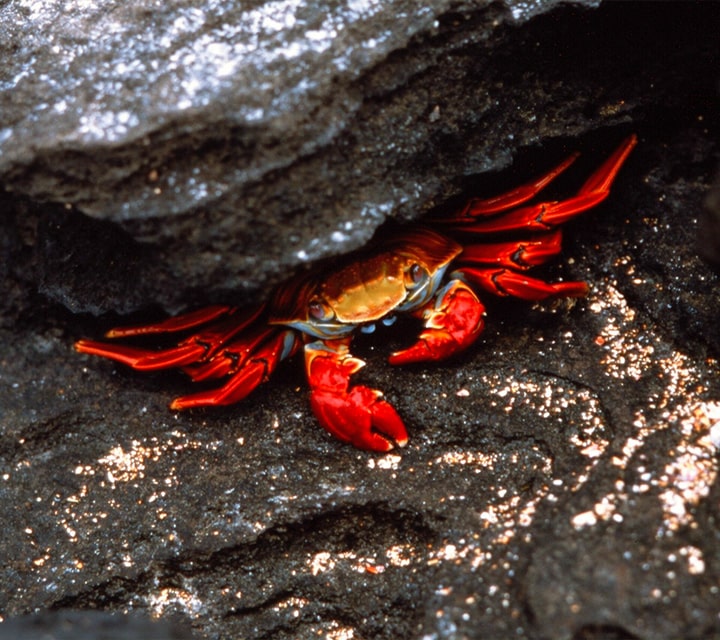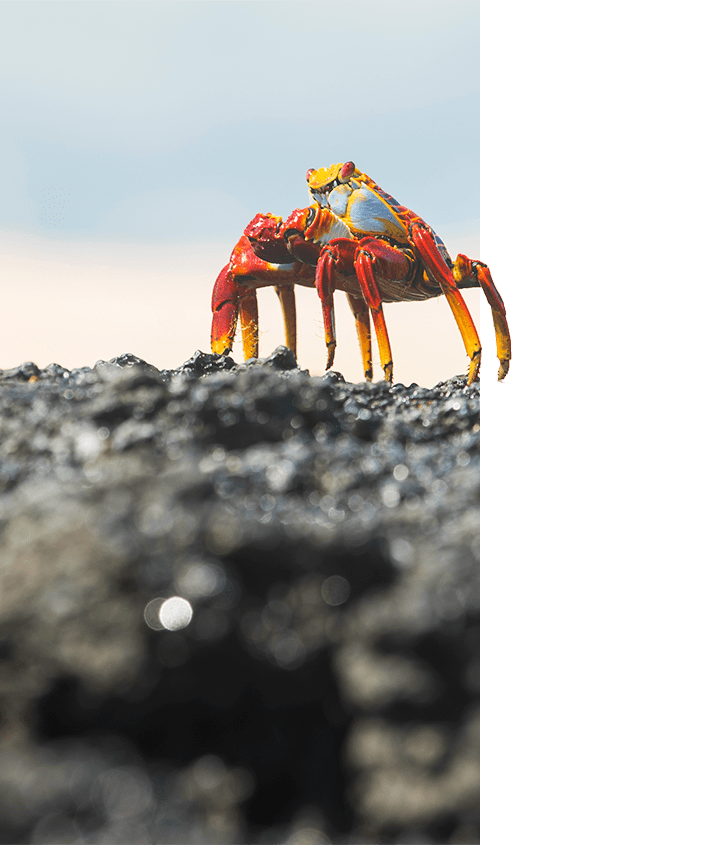
Meet the Sally Lightfoot Crab, aka rainbow warriors. These vibrant creatures are not just a feast for the eyes; they're also masters of survival, darting across the Galapagos shores. As you read on, you'll learn about their striking blue, orange, and red shells that shield them from predators and how they navigate both land and sea with remarkable agility.
Dive into where these crabs thrive within the unique ecosystems of the Galapagos Islands. Understand their complex reproductive rituals ensuring future generations flourish against all odds. Plus, discover their symbiotic roles in one of Earth's most diverse habitats. Get ready to explore facts that transform your view of these fascinating crustaceans.
JUMP TO SECTIONS:
- Captivating Colors and Physical Traits of Sally Lightfoot Crabs
- Daily Life and Behaviors of the Agile Sally Lightfoot Crab
- The Coastal Realm of Sally Lightfoot Crabs
- Reproductive Rituals and Developmental Stages
- Symbiotic Relationships with Galapagos Wildlife
- FAQs on Sally Lightfoot Crabs
- Conclusion
Captivating Colors and Physical Traits of Sally Lightfoot Crabs
Picture the Galapagos Islands, a tapestry of nature's finest work, where the Sally Lightfoot crab scuttles across rocky shores. This crustacean isn't just another rock crab; it’s an artist’s muse with a carapace canvas painted in vibrant light blue and red hues. Now, why are they called “Sally Lightfoot”? Well, legend has it that their nimble moves could make any dancer green with envy.
Dazzling Hues and Hardy Shells
The Sally Lightfoot crab, or as scientists call them, Grapsus grapsus, sports a color scheme that pops against the black lava rocks typical of its home turf. But these aren’t fashion statements—they're survival gear. The younger ones play it cool with darker brown shades to sneak around unnoticed by predators lurking in shallow water. As they grow older and bolder, they don bright colors—a badge of age showing off their agility to dodge danger at every turn.
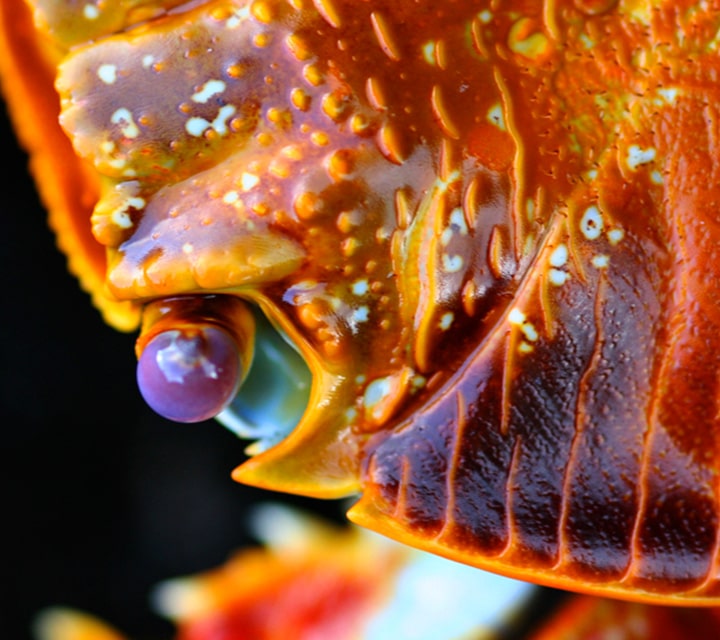
You might think such colorful creatures would be easy targets for hungry marine iguanas or sharp-eyed lava herons—but think again. Their hardy shells are more than meets the eye; this exoskeleton is like a knight's armor built tough enough to withstand pecks and prods from pesky predators trying their luck. And measuring up at about 5 inches on average means these crabs can hold their own when things get rough on tide pools' dance floors.
Masters of Movement on Land and Sea
A glimpse into the daily life of Sally Lightfoot crabs reveals much more than your average beach bum lifestyle. These critters have mastered both land and sea maneuvers that would put Olympic athletes to shame: skimming over water surfaces (don't mistake this for walking on water) or making leaps onto shore rocks—all while avoiding getting cornered by craftier foes.
No lazy days soaking up sun rays for these agile arthropods; instead, you'll find them actively scouting food during daylight hours year-round—yes, even Christmas if you wondered! Whether navigating through tricky terrain or catching lunch (Bird eggs? A side dish), there's no room for slip-ups here, because being fleet-footed is literally life-saving in their world.
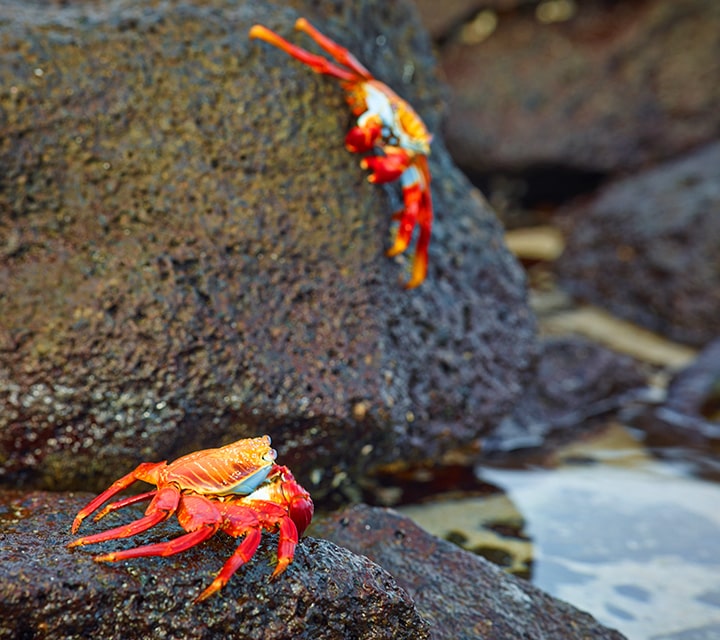
There we go—like explorers uncovering hidden gems among ancient ruins—we've delved deep into what makes our little friend so captivating beyond its pretty shell exterior. We uncovered not just the striking beauty but also the brilliant adaptations these colorful creatures use to thrive where waves crash and a plethora of wildlife abounds. It's an experience that far surpasses any armchair travel adventure, immersing us in nature’s own spectacular narrative.
Key Takeaway:
Meet the Sally Lightfoot crab, a dazzling dancer of the Galapagos with colors that confuse predators and shells tough as armor. These nimble critters are survival experts, dodging danger with Olympic-level agility on land and sea, proving there's more to them than meets the eye.
Daily Life and Behaviors of the Agile Sally Lightfoot Crab
Imagine a creature that embodies the spirit of a seasoned rock climber and an Olympic sprinter. That's your Sally Lightfoot crab, active during daylight hours all year round. They've mastered the art of navigating lava rocks with finesse, moving with such agility it seems as though they're performing an intricate dance choreographed by nature itself.
Masters of Movement on Land and Sea
Sally Lightfoot crabs are not just good movers; they're exceptional ones. These crabs make their home among treacherous terrain where waves crash against sharp lava rocks, yet they scuttle about like it's a walk in the park—or rather, a scamper over volcanic stone. Their ability to “walk on water” is actually quick movement across small pools or wet surfaces that gives them this mystical appearance.
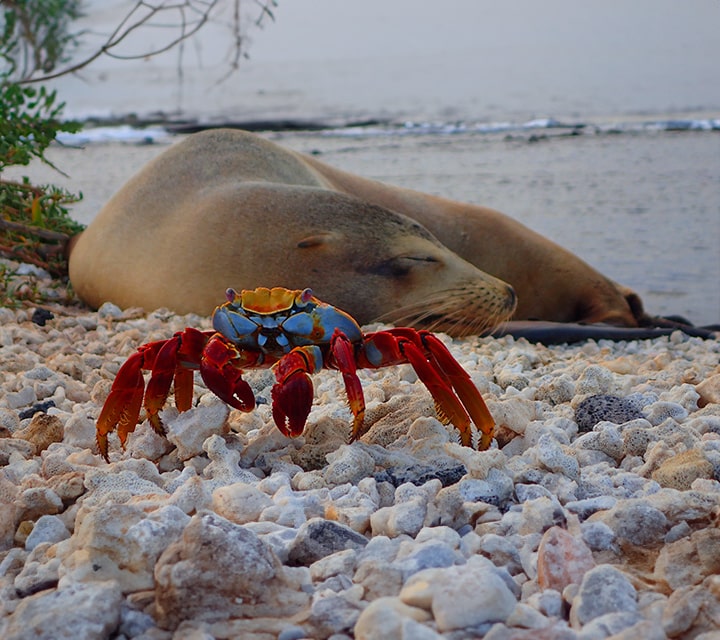
But why do these crustaceans even bother with such acrobatics? Well, survival doesn't come easy in the Galapagos Islands—predators lurk around every corner from hungry sea birds to crafty marine iguanas looking for a snack. This need for swift movements has turned our red-rock friends into daytime adventurers who can escape danger at what looks like blue smoke speed.
Their lifestyle isn't just about dodging predators; there’s also grub hunting involved—a lot of it. Crabs don’t get those dazzling colors from sunbathing alone but through their diet too: munching on algae along shorelines or feasting opportunistically on anything from bird droppings to sea lion placenta (yes, you read that right). It may not be five-star dining by human standards, but hey—it keeps those shells nice and vibrant.
To see these agile creatures in action is something straight out of travel books—an experience both surreal and spellbinding when witnessed firsthand during Galapagos adventures. No wonder John Steinbeck found them fascinating enough to write about in his logbooks!
A glimpse into their daily routines reveals more than mere survival tactics; we observe social interactions as well—which aren’t always friendly chats over tea time either. You might think twice before calling Sally Lightfoots passive after watching how aggressive they can get while defending territory or competing for food resources within large groups alongside fellow Galapagos wildlife.
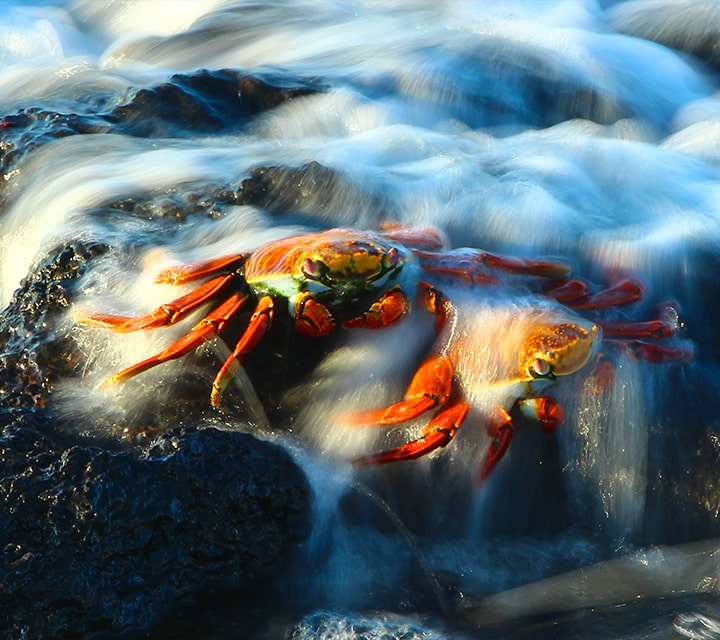
This mix of dynamic behaviors makes studying Sally Lightfoots nothing short of compelling—whether you’re viewing them up close while perched upon black lava cliffs or observing their tiny hatchlings scuttle about. Their adaptability and resilience in the face of harsh coastal conditions are remarkable, providing endless fascination for researchers and nature enthusiasts alike.
Key Takeaway:
Sally Lightfoot crabs are nimble rock climbers and swift movers, essential for dodging predators and finding food in the Galapagos. Their colorful diet contributes to their vibrant shells, while their competitive social lives add another layer of intrigue to these fascinating creatures.
The Coastal Realm of Sally Lightfoot Crabs
Scuttle over rocky shores and you might just spot the vibrant scamper of a Sally Lightfoot crab. These critters are more than just eye candy in the Galapagos Islands; they're a wonder to behold, darting across black lava rocks with the finesse of seasoned acrobats.
Most beaches and shallow waters around these famed islands serve as stages for their daily performances. As if dressed for a gala, they flaunt shells adorned in shades that could make rainbows envious. It's not all about looks though; those hardy exoskeletons shield them from unforgiving elements—think sea spray meets sun-kissed armor.
For any nature enthusiast or curious traveler thumbing through travel books or browsing travel blogs, seeing these crabs is like witnessing living art against nature's canvas—a must-add to your wildlife bucket list.
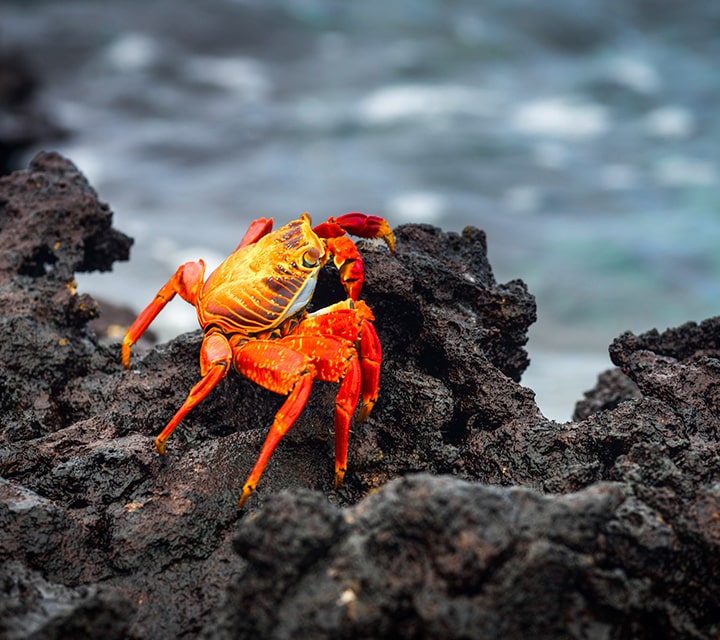
Dazzling Hues and Hardy Shells
Sally Lightfoots don't shy away from fashion statements—their carapace sports an average size around 5 inches but it’s their palette that steals the show. Youngsters often start out dark brown or black, gradually earning their hues like stripes of honor as they mature into adults splashed with red-rock inspiration.
The crab's wardrobe isn’t just fancy wordplay; it serves real-world purposes too. While predators loom on land and underwater, these colorful crustaceans can slip unnoticed among patches of algae-covered stones or dash off leaving nothing but blue smoke behind—or so one would think given how quickly they vanish into thin air (or water).
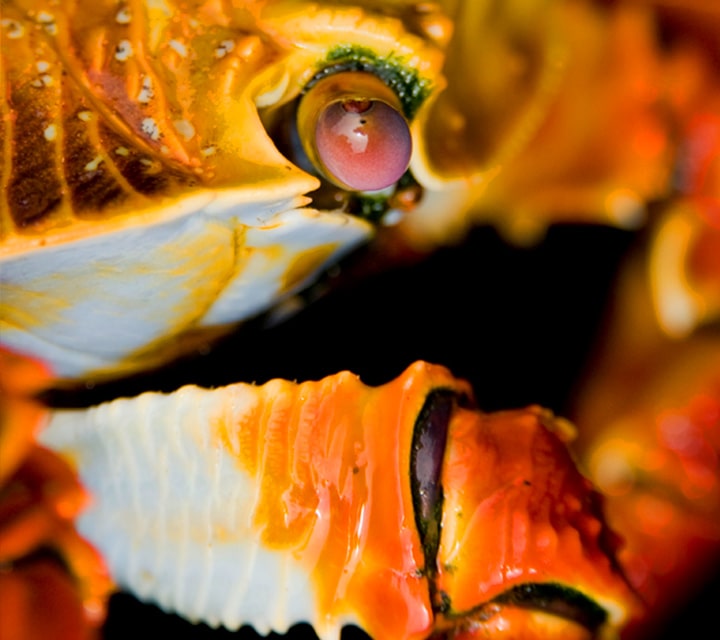
Masters of Movement on Land and Sea
You've got to see them to believe them. Imagine agile athletes able to sprint sideways at warp speed—that’s your average Sally doing her thing on terrain most wouldn't dare tread upon without proper hiking boots, let alone eight legs. They climb steep slopes effortlessly, making shore rocks look like flat sidewalks in comparison.
In case you’re wondering, they can also swim, although calling what Lightfoots do “swimming” feels almost underwhelming when compared with Olympic swimmers' standards, yet quite impressive considering we're talking about crabs here, folks. Their ability isn’t limited by liquid boundaries either: some have been seen skirting water surfaces mirroring moves straight out of Caribbean dancer handbooks.
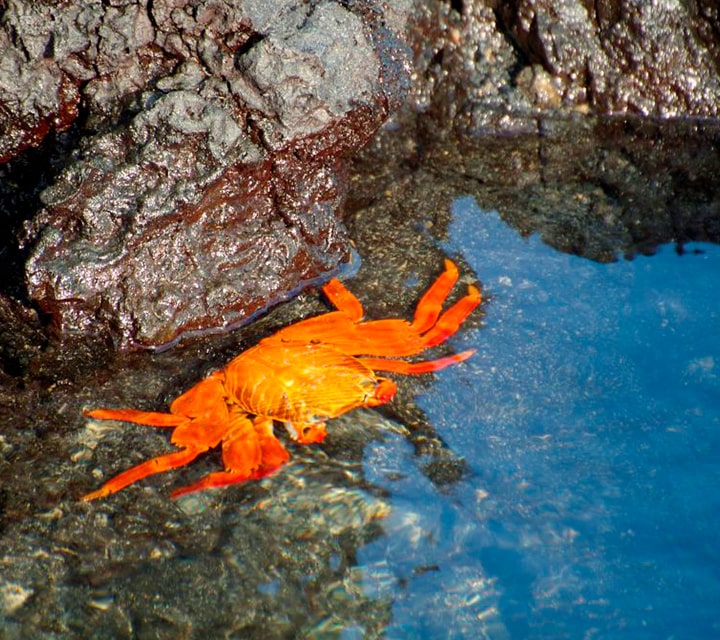
Key Takeaway:
Sally Lightfoot crabs are not just vibrant eye-catchers in the Galapagos; they're natural acrobats with dazzling colors and shells that serve as both fashion statements and armor. Agile on land and nimble in water, these creatures are living art—essential for any wildlife enthusiast's bucket list.
Reproductive Rituals and Developmental Stages
From carrying eggs to hatching larvae, learn about the reproductive cycle that sustains Sally Lightfoot populations.
Dazzling Hues Signal Mating Time
The bright blue and red colors of Sally Lightfoot crabs aren't just for show; they play a crucial role during mating season. These dazzling hues become even more pronounced in adults ready to breed, signaling to potential mates that it's time to pair up. It’s like nature’s own neon sign flashing across the black lava rocks: “Breeding season here!”
Females carry eggs on their stomachs after mating—a sight often witnessed by visitors exploring tide pools or observing marine iguanas lounging nearby. But don’t let this serene image fool you; female Sally Lightfoots are diligent mothers who protect their precious cargo until they release them into the water where larvae begin life's journey.
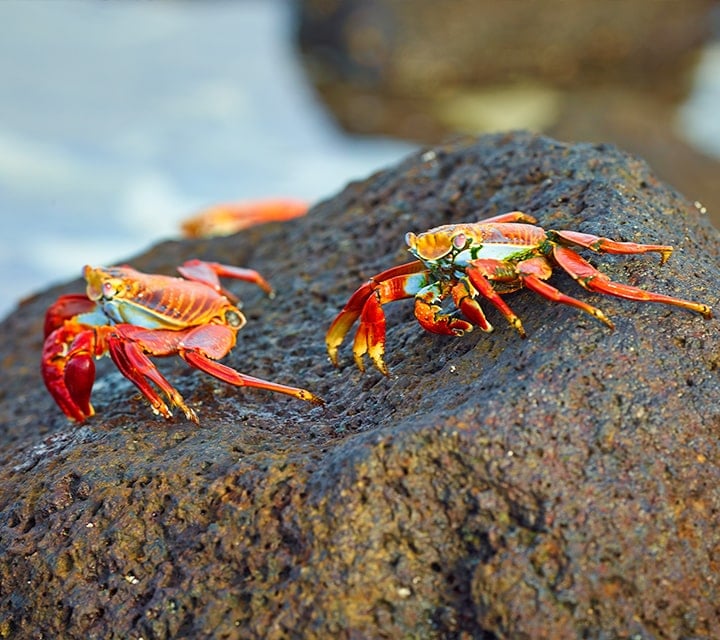
From Eggs to Explorers: The Larval Journey
The transition from egg-laden mother crab to independent larva is an aquatic ballet set against currents around the Galapagos archipelago. When young Sally Lightfoot crabs hatch, they're not yet equipped with those iconic hardy shells or adept at scuttling across shore rocks like their parents.
In this delicate larval stage, they seek out phytoplankton—tiny organisms drifting through sea spray—starting off life with quite possibly one of Mother Nature's smallest buffets. The larvae grow and molt repeatedly, gaining strength and size each time until finally settling onto land where juvenile antics commence among shallow waters' safety.
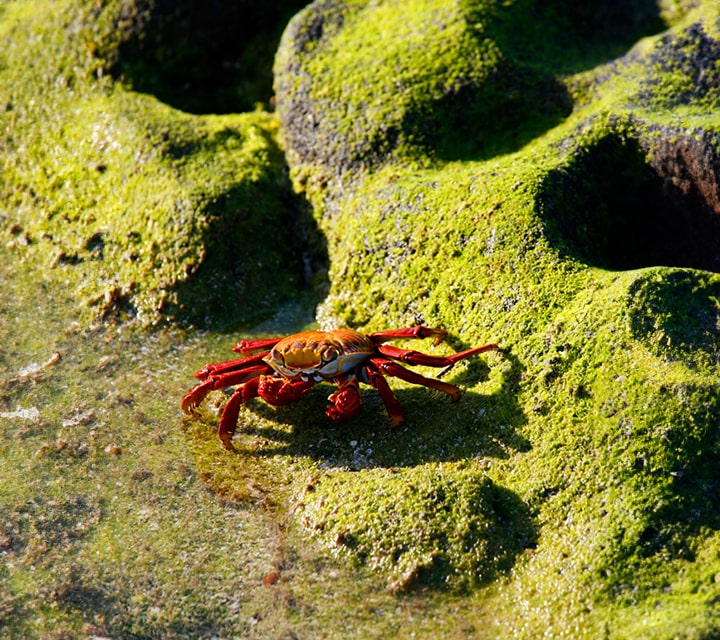
Navigating Early Life Amongst Giants
You can spot baby Sally Lightfoot crabs sporting darker brown tones instead of adult vibrancy amidst large groups along coastlines—a strategic choice since blending with dark volcanic rock keeps them hidden from predatory eyes while learning essential survival skills such as dodging sea lion placenta-seeking birds or evading hungry tide pool residents eager for an easy snack.
So there you have it—Sally Lightfoot crabs' circle of life unfolding before our eyes within unique ecosystems found only here in these enchanted islands we love so much—the Galapagos.
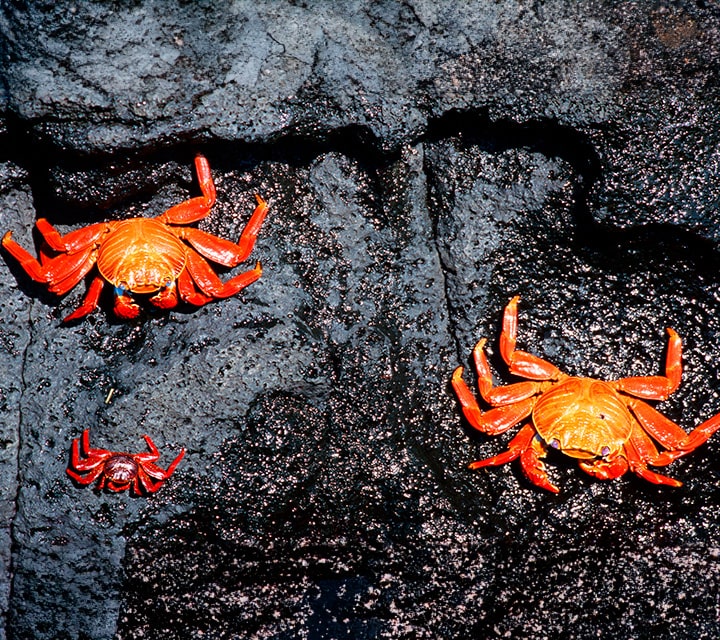
Key Takeaway:
Dive into the world of Sally Lightfoot crabs, where dazzling colors signal breeding time and larvae embark on a life journey from eggs to explorers in the Galapagos currents.
These vibrant creatures carry out a complex reproductive dance, with females dutifully guarding their eggs until they hatch and baby crabs navigate early life amongst island giants.
Symbiotic Relationships with Galapagos Wildlife
The Sally Lightfoot crab, a kaleidoscope of color against the black lava rocks of the Galapagos Islands, isn't just another pretty face in this diverse ecosystem. These crabs are key players in a delicate dance of give-and-take that keeps life thriving along these rugged shores.
Cleaners on Duty: The Helpful Clawed Custodians
Picture this: marine iguanas basking under the equatorial sun while Sally Lightfoot crabs scuttle around them like busy janitors at work. But they're not after crumbs; instead, they feast on ticks and dead skin from their reptilian neighbors. It's not out of kindness—these crustaceans are getting a free meal and helping keep the iguanas clean and healthy. Think of it as nature's spa treatment where everyone leaves satisfied.
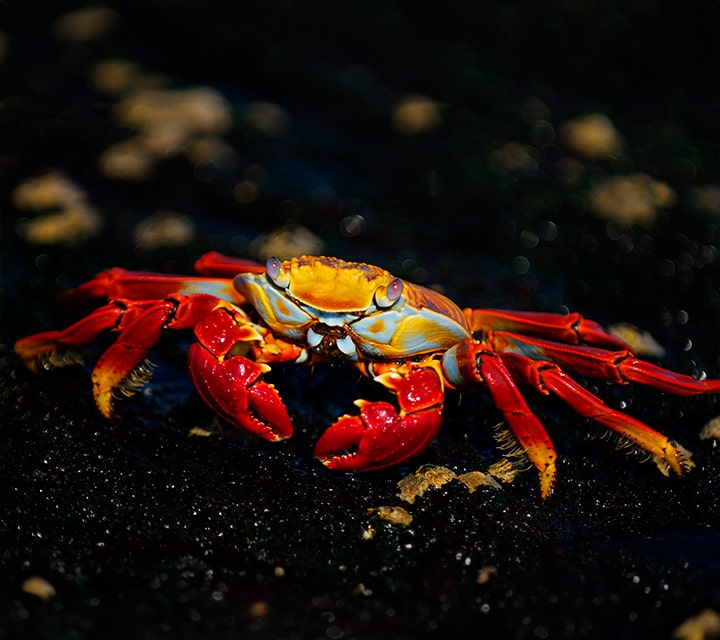
This mutually beneficial relationship doesn't stop there; sea lions also get spruced up by these diligent decapods. After feasting on sea lion placenta post-birth—a bit grisly but waste-not-want-not in nature—the young Sally Lightfoot crabs grow into adults ready to pick parasites off other animals or chow down on bird droppings left behind by winged residents.
Predator Corners and Prey Dynamics
But life isn't all about leisurely cleaning sessions for our nimble friends—they've got predators lurking around every corner. Lava herons eye them hungrily from above tide pools while hungry shore rocks might hide sneaky octopuses reaching out with tentacles faster than you can say "crab cakes." In such treacherous waters (quite literally), Sally Lightfoots must always be alert.
In fact, partaking in underwater acrobatics is more than just showing off—it’s a crucial survival tactic for when an urchin crab gets too close or when water surface tension becomes a matter-of-life-or-death escape route from prowling predators below.
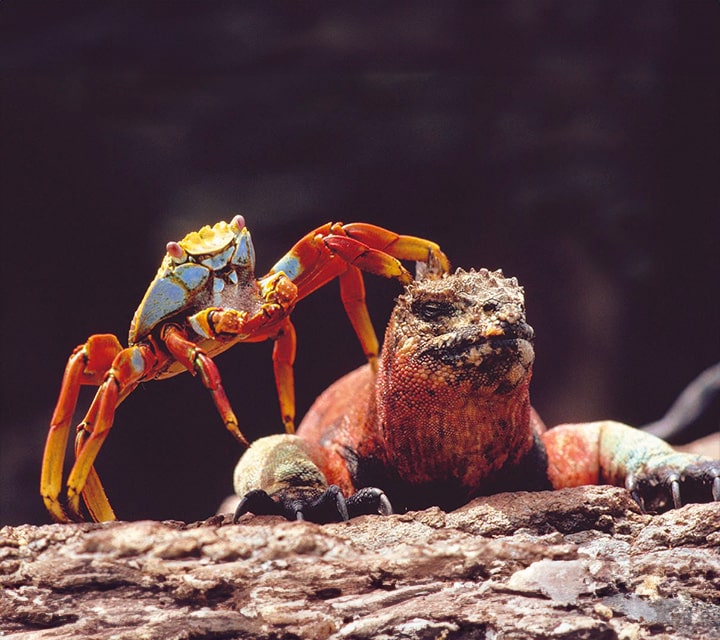
Dining Habits: From Sea Spray to Sun Protection Hat Snacks
You might think all that running away would leave little time for dining, but fear not—Sallys have quite varied tastes ranging from algae scraped off shallow water bedrock to nabbing snacks directly under tourists' sun protection hats (talk about bold). And don’t forget those special occasions when they happen upon delicacies like bird eggs during nesting season; talk about being opportunistic feeders.
The importance of such dietary diversity cannot be overstated, both keeping individual populations healthy through nutrient intake variety as well as ensuring broader environmental impacts remain balanced.
With every step forward in the digital landscape, businesses face new challenges and opportunities. As we navigate these changes, it's crucial to stay informed and adapt quickly.
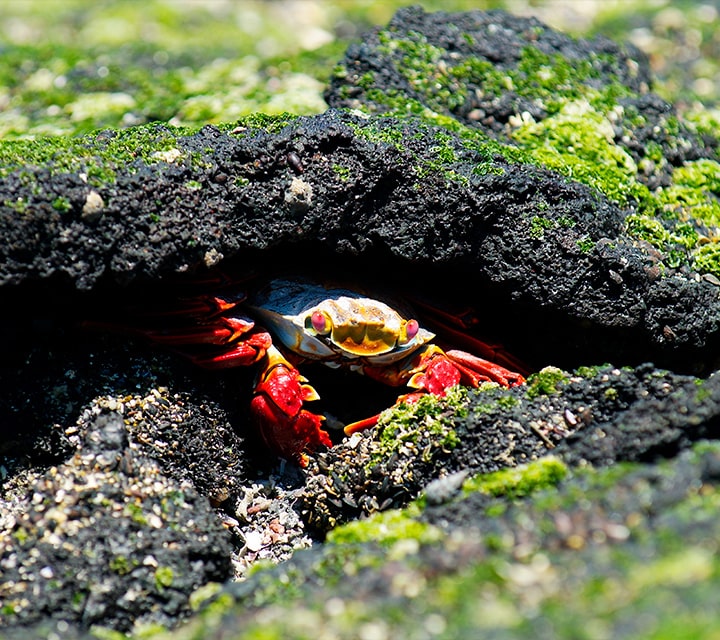
Key Takeaway:
Sally Lightfoot crabs are more than colorful creatures; they're vital to the Galapagos ecosystem, serving as both cleaners and prey while showcasing a diverse diet that keeps their world in balance.
Conclusion
Discovering 8 Amazing Sally Lightfoot Crab facts has been a journey into the vibrant lives of these Galapagos gems. Remember their stunning blue, orange and red shells, nature's own sun protection hats. Recall how they scuttle with ease over shore rocks and through tide pools.
Picture them thriving on black lava shores amid sea spray and under the watchful eyes of Marine Iguanas. Understand now why baby Sally Lightfoot crabs seek out phytoplankton to kick-start their survival in those shallow waters.
Consider their role as cleaners, maintaining balance within ecosystems by dining on algae or even bird droppings. Realize that while they may appear aggressive when cornered by predators, it’s all part of being agile survivors—true rainbow warriors.
You've learned much about these fascinating creatures; let it inspire you to visit them during a Galapagos Luxury Cruise & respect for every life form adapting to thrive in our world's unique habitats.
